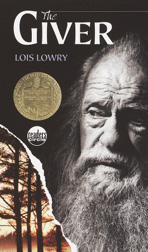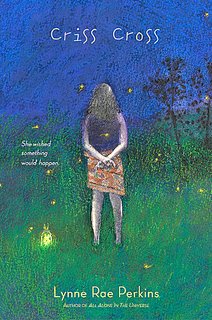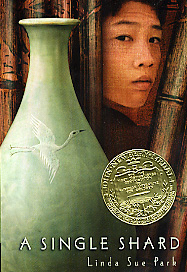
Book Review: THE GIVER
*NOTE: This review was created for a class at TWU.
1. BIBLIOGRAPHY:
Lowry, Lois. 1993. THE GIVER. New York, NY: Dell Laurel Leaf. ISBN 0440237688
2. PLOT SUMMARY:
In THE GIVER, Lois Lowry's 1993 Newbery Medal-winning novel, Jonas lives in a world without fear or pain. All aspects of life in the community are stable, polite, and completely under the control of the Committee of Elders, from birth to death. This state of existence is fine with Jonas until, at the age of twelve, he is unexpectedly named Receiver of the community's collective memories. These memories are transmitted to him by the Giver, and as Jonas learns what has been sacrificed for the sake of stability, he realizes that he must risk everything and escape.
3. CRITICAL ANALYSIS:
"But at the same time, he was filled with fear. He did not know what his selection meant. He did not know what he was to become.
Or what would become of him." (The Giver, Ch. 8)
In four short sentences, Jonah, the main character of THE GIVER, conceptualizes the fear and uncertainty felt by all young adults when confronted with what they will become in the future and what society expects them to become. The simplicity of the world Lois Lowry creates in this novel, coupled with the spare and direct style of narration, allows the author to bring many of the major themes in young adult literature to the forefront of THE GIVER, resulting in a story which is both thought-provoking and unique in its clarity.
Because the prevailing themes in young adult literature include self-awareness and rebellion against the established order, the genre of dystopia is particularly suited this type of literature. As young adults become more aware of themselves in a quest to discern what their individual identity is, they in turn become more aware of the world around them and begin question the status quo. Dystopias add an element of fantasy, such as magic and other worlds, to this journey of self-discovery, often pitting the protagonist against newly discovered evil, transforming self-discovery into heroism. THE GIVER is a dystopia which succeeds in doing all this in a style that is engaging and touching without flowery prose that would distract from the important questions raised by Jonas's plight.
In the beginning, Lowry paints a picture of life which, while not perfect, is safe and comforting in its sameness. Everyone knows the rules and the status quo prevails. Students begin each day with "chanting" and a "morning anthem," performing polite public apologies when rules are broken, and being reminded over loudspeakers of the consequences of infractions. Each day ends with a ritual too, "the evening telling of feelings." While this stable life seems gentle and protective, Jonas's increasing sense of self-awareness causes him to be uncomfortable with the constraints of his community. He is reluctant to engage in the telling of feelings, finding them to be too complex, thinking that, "He wanted to share them, but he wasn't eager to begin the process of sifting through his own complicated emotions, even with the help that he knew his parents could give."
By the time Jonas is singled out from the rest of his age group to be appointed the special job of Receiver, his journey of self-discovery has also become a journey toward independence. This journey is facilitated by his growing curiosity about the world around him. Jonas questions everything, and is encouraged by his mentor, the Giver of memories. When he begins to see colors, he questions why no one else can see them. "Why can't everyone see them?" Jonas asks, "Why did colors disappear." At this point, Jonas learns that colors were "relinquished" when the community did away with differences, gaining control of one thing, but having to give up others.
From here, THE GIVER becomes dystopic, and Jonas's realization that the loss of freedom, beauty, and passion are too great a price to pay for sameness and safety, turns his journey of self-discovery into a quest for survival. When he decides to flee the community, which would release the memories he has received back to everyone, he takes with him Gabriel, a baby who going to be killed because he didn't fit in to the community's norms. At this moment, he heroically risks his own life, and transforms himself from Receiver of memories to Giver of life and the future. Almost dead with exhaustion, hunger, and cold, Jonas protects the baby and becomes "aware with certainty and joy that below, ahead, they were waiting for him; and that they were waiting, too, for the baby."
Lowry offers an optimistic ending echoing with allusions to the nativity, but one which is open-ended enough for the reader to form his or her own interpretation. THE GIVER is not didactic. In fact, this very open-endedness has caused the book to be controversial to some, who see in some of the Biblical allusions such as Jonas's and Gabriel's name, and the Christmas-time setting, a condemnation of religion. Yet it is that very freedom of interpretation for which the novel stands. THE GIVER poses serious questions about society's constraints in the interest of the "common good" without giving answers so that, like Jonas, the reader can "sift through" his or her own complicated thoughts independently.
4. REVIEW EXCERPT(S)
School Library Journal: (Starred Review) "The final flight for survival is as riveting as it is inevitable. This tightly plotted story and its believable characters will stay with its readers for a long time."
Booklist: (Starred Review) "The simplicity and directness of Lowry's writing force readers to grapple with their own thoughts."
5. CONNECTIONS & STRATEGIES
* Use color and music to springboard a discussion about the things the community gives up in order to be more "secure" and "safe." Put large sheets of butcher paper in different colors around the room. Students stand at each sheet for five minutes, writing down the things and feelings that come to mind when they think about that color. Then do a gallery walk, discussing each color and reflecting on feelings and connotations that shared by our society and why a society might want to avoid those feelings and connotations. A similar exercise would be to play clips of various songs and have students journal about the emotions those songs evoke. Why would a community want to ban music? Finally, students could journal on what things (if any) they would be willing to give up to make their community safer. For a lesson plan along these lines, go to http://www.teachers.net/lessons/posts/664.html
* At the high school level, this book would be an excellent choice in a genre study of dystopias in a book study or reader's circle format. The teacher could do brief book-talks about 5-6 dystopias such as Aldous Huxley's BRAVE NEW WORLD (ISBN 0060929871), Ray Bradbury's FARENHEIT 451 (ISBN 8445074873), George Orwell's 1984 (ISBN 0451524934), and Margaret Atwood's A HANDMAID'S TALE (ISBN 038549081X). Along with these classics, some contemporary dystopias include M.T. Anderson's FEED (ISBN 0763622591), Scott Westerfield's UGLIES (ISBN 0689865384) and PRETTIES (ISBN 0689865392), Susan Beth Pfeffer's LIFE AS WE KNEW IT (ISBN 0152058265), and Nancy Farmer's HOUSE OF THE SCORPION (ISBN 0689852231). After the book talks, student self-select which book they'd like to read and create groups of students who are reading the same book. Through journals, textual analysis, and discussion, students will identify the elements of a dystopia found in the book and report out to the rest of the class. Students may be assigned roles such as Connection Maker, Illustrator, Vocabulary Sleuth, etc., so that each will have an important part to play in the work and presentations. Harvey Daniels has some great ideas for book clubs in Ch. 9 of his book, SUBJECTS MATTER (ISBN 0325005958)




